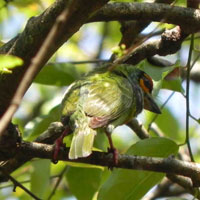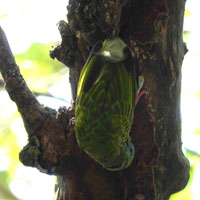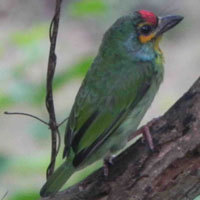By Jagath Gunawardana
The commonest and most widespread of all endemic birds in Sri Lanka is the Small Barbet, which is also known as the Crimson-fronted Barbet, found in many home gardens and even in busy towns, including Colombo.
It is often heard than seen and rather difficult to locate by the call.
The Small Barbet is an arboreal bird that is always found on trees, prefers upper branches and does not come down to less than three metres (10 feet). It is usually found alone or as pairs but is occasionally seen in small flocks.
A peaceful bird, it can be seen in the company of other species, especially when feeding, never showing any aggression to others of the same species or towards other species.
The green colour of its body provides it with a perfect camouflage and it is difficult to spot it when lurking amongst the foliage. Its flight is fast and powerful with rapid fluttering of the wings. It often makes short flights between trees but can easily fly over a distance when needed.
The call is a loud continuous and metallic ‘tonk-tonk’ note, somewhat similar to the sound emitted when a piece of metal is pounded by a hammer. It is this call that has earned it the name Ceylon Coppersmith. This call is uttered either as a low monotone or as a rapid, rhythmic and repetitive call that is pulsating and forceful.
When calling, it usually gets into the topmost branches of a tree that gives a good view. The calling is unusual as it is always uttered with the beak closed. The force made during calling causes the throat to puff out and the sides of the face balloons out while the body is jerked to and fro with each note.
The calls are often accompanied with the swaying of the head from side to side along a wide arc which enables one syllable to be heard louder than the accompanying syllable which may be heard quite low. It gives an impression that the notes are coming from two different places and makes it difficult to locate the calling bird. The calling may go on for ten to fifteen minutes continuously and the loud calling can be heard up to a distance of 300 metres or more – a remarkable feat for a small bird.
The Small Barbet feeds on fruit and is not particularly choosy in food preferences, feeding on any available food, though it prefers small fruit if given the choice. In home gardens, it is often seen feeding on guavas, rose-apple (jambu) and jam fruit. Smaller fruits are swallowed whole. Slightly larger fruits are crushed between the mandibles to reduce it to a manageable size and make them tender and portions are pecked out methodically from one place.
It is a gluttonous and messy feeder that often gets soiled when feeding on juicy fruits. This is due both to the habit of crushing fruits and also the habit of inserting the head deep in to ripe pulp. It will look unkempt and bed ragged after such a bout of feeding.
The breeding season is during the first half of the year and the majority of nesting occurs during March and April. Its calling is incessant and loudest during courtship. It nests in a hole in a tree, often made by the pair. It prefers dead branches and soft wood that is easy to dig. The two or three eggs are white in colour.
Both parents take turns in incubating eggs and feeding their young. The young birds stay with the parents for some months, forming a small family party. Young birds are similar to the adults in general appearance but lack the red forehead. Other colours on the face are considerably paler.
The Small Barbet is found throughout the low country wet and dry zones and in the hills up to 1,300 metres (4,000 feet). It is a common bird, but escapes the attention of many due to the colouration. It needs tall trees and is never found in places where there are only bushes. It is even found in Colombo and is present in the busy Fort and Pettah areas where it can be readily seen when Nuga and Bo trees bear fruit. It has declined in areas where there are only a few or no tall trees but has increased in numbers in other areas.
It is not shy of human presence and does not get frightened by the noise made by traffic and other human activities. The only bird that can be confused with the Small Barbet is the Crimson-breasted Barbet. However, it has a bright lemon-yellow on the its face instead of blue, and the breast has dark green streaks on a yellow-green background as opposed to the uniform green breast and abdomen of the Small Barbet.
The Small Barbet is yet another species of bird whose status has gone through a full circle. It was initially considered as an endemic species. However, Hugh Whistler, who conducted the Avifaunal Survey of Sri Lanka, considered it to belong to the same species (con-specific) with the Crimson-throated Barbet of South India.
This relegation of status from an endemic species to an endemic sub-species was accepted in all subsequent works in India and Sri Lanka. The elevation of its status (or rather the restoration of the status) to an endemic species was done by Sybley and Munroe in 1991.
Fact sheet
-Barbets belong to the family Capitonidae and are small to medium-sized birds, characterized by stoutly-built, stocky bodies.
-Four members of this family are found in Sri Lanka and are residents. Two of them are endemic species.
-The Small Barbet (Megalaima rubricapilla), also known as the Crimson-fronted Barbet, Ceylon Coppersmith and the Sri Lanka Coppersmith, is known as the ‘Mal-Kottoruwa’ in Sinhala.
-It is about 15 centimetres (six inches) in length, and is slightly larger than a House Sparrow but with a more robust build.
-The body is a dark, bright green and is darker on the upper parts.
-In contrast, the head has five colours. The forehead and the fore-crown is a dark crimson red, and the rest of the crown and the nape are of the same green found in the upper parts. The eye is surrounded by a broken ring of orange-yellow. The chin and throat are of the same orange-yellow.
The throat patch terminates in a scarlet red band or narrow patch on the upper breast. A cobalt blue colour is found on the sides of the face and this extends to the beak on the anterior and to the sides of the neck on the posterior. The red forehead and the yellow eye-ring are bordered with black.
-The beak is black, the legs and feet are pink-red or red, and the nails are pale brown.
-The males and females are similar in appearance courtesy: Ceylon Today





